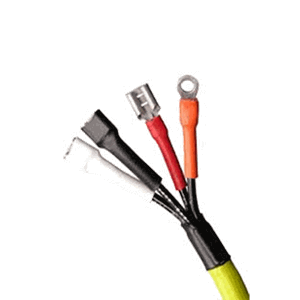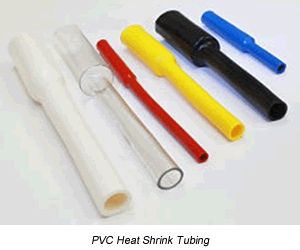Product Focus: How to Choose Shrink Tubing Size and Material
Product Focus: How to Choose Shrink Tubing Size and Material
Understand Your Application
 The most important step in choosing the appropriate heat shrink product for your needs is to understand and define all the factors necessary for your application to succeed. The only way to ensure that you’re getting the most appropriate, cost-effective product is to fully understand your application and the requirements that need to be met.
The most important step in choosing the appropriate heat shrink product for your needs is to understand and define all the factors necessary for your application to succeed. The only way to ensure that you’re getting the most appropriate, cost-effective product is to fully understand your application and the requirements that need to be met.
Sizing Requirements
Regardless of whether you’re using heat shrink tubing in an electrical application, as a strain relief, as a protective covering, or for any other reason, determining the correct size is of the utmost importance. The two most important dimensions to measure for your application are the largest diameter that the expanded sleeve needs to slide over and the smallest diameter that the tubing needs to completely cover after shrinking. These two dimensions will be used later to help you determine the required size and shrink ratio for your tubing. If either of these locations has a non-circular profile, you will need to convert the non-circular perimeter to a diameter. To do this, you must measure the total perimeter at this location and divide that number by pi (or 3.14). This will give you an “effective” diameter, which you can use to help determine the tubing size you need.
Another important dimension to consider is minimum wall thickness. A certain minimum wall thickness might be required, due to the electrical requirements of your application. Or, if the tubing is going to be subjected to excessive abrasion or wear, you may wish to have a heavier wall thickness than the standard size offers. In addition to defining your required minimum wall thickness, it is also necessary to determine the diameter at which this wall thickness will be required.
Electrical Property Requirements
If your heat shrink tubing is going to provide electrical insulation or bundle electrical wires, it is likely that it needs to meet certain regulatory guidelines. In order to choose the correct product for your application, you’ll need to know if any UL/CSA (Underwriters Laboratories/Canadian Standards Association), ASTM (American Society for Testing and Materials), AMS (Aerospace Material Specification), EU (European Union), or other automotive or military specifications need to be met. These guidelines usually cover common electrical requirements such as dielectric strength and flame resistance. Other possible electrical requirements could be that the tubing must be free of halogens or that it must be made out of a specific material. Make sure you understand all of the electrical requirements before you choose your heat shrink product.
Operating Environment
Another critical step in defining the requirements of your heat shrink tubing application is to understand the environment in which the tubing will operate. For example, will the tubing be subjected to excessive abrasion or flexing? Will the tubing come into contact with any oils, greases, fuels, chemicals, or other fluids? It is also important to know if the tubing will be used indoors or outdoors. If it is going to be used outdoors, it could be subjected to excessive UV exposure. If it is going to be lying on or buried below the ground, it may need to have superior resistance to fungus growth. Finally, an enhanced environmental seal (as obtained with adhesive-lined heat shrink tubing) may be needed to protect any sensitive portion of the object the tubing is covering. All of these factors need to be considered prior to selecting your heat shrink product.
Choose the Appropriate Heat Shrink Material
Once you have defined all that is necessary for your application and have chosen the appropriate tubing size, you are ready to choose your heat shrink material. Often, multiple products will meet your needs, so it is important to also know the cost and availability of each option. This section will examine how to choose the right material by differentiating each by cost and capability.
Available Heat Shrink Tubing Materials
A common misconception among heat shrink users is that there is only one heat shrink material. While polyolefin is the most widely used material, PVC heat shrink tubing can be a cost-effective alternative for many applications. In addition to the polyolefin and PVC material families, specialty heat shrink tubing is available in various fluoropolymers and elastomeric materials. Within each of these material families are many different compounds, which are designed to excel in certain environments and/or meet particular specifications.
PVC or Polyolefin?
 Polyolefin is the most commonly used heat shrink material. Its advantages lie in the cross-linking of polymer chains, which allow it to withstand high temperatures in the 125°C-135°C (257°F -275°F) range. However, a common misconception is that “heat shrink is heat shrink”; that is, all heat shrink is the same and it doesn’t matter what you choose. While PVC cannot withstand the highest temperatures that polyolefin can, there are many advantages to using PVC. The most important benefit to using PVC heat shrink tubing is lower cost. PVC generally costs anywhere from 10% to 60% less than polyolefin. If your application involves an operating environment in which the continuous high temperature is 105°C (221°F) or less, you should strongly consider PVC heat shrink for the cost savings alone. In addition to the significant price difference, PVC also offers brighter, more vibrant colors than polyolefin as well as considerably better clarity in its clear version. Custom colors and transparent tints are also available with PVC heat shrink, but typically not with polyolefin heat shrink.
Polyolefin is the most commonly used heat shrink material. Its advantages lie in the cross-linking of polymer chains, which allow it to withstand high temperatures in the 125°C-135°C (257°F -275°F) range. However, a common misconception is that “heat shrink is heat shrink”; that is, all heat shrink is the same and it doesn’t matter what you choose. While PVC cannot withstand the highest temperatures that polyolefin can, there are many advantages to using PVC. The most important benefit to using PVC heat shrink tubing is lower cost. PVC generally costs anywhere from 10% to 60% less than polyolefin. If your application involves an operating environment in which the continuous high temperature is 105°C (221°F) or less, you should strongly consider PVC heat shrink for the cost savings alone. In addition to the significant price difference, PVC also offers brighter, more vibrant colors than polyolefin as well as considerably better clarity in its clear version. Custom colors and transparent tints are also available with PVC heat shrink, but typically not with polyolefin heat shrink.
Two other advantages PVC holds over polyolefin are: 1) Clear PVC is flame retardant, while clear polyolefin is not, and 2) PVC is much tougher than polyolefin, with better tensile strength and abrasion resistance. If your operating temperature is 105°C (221°F) or less, it is strongly recommended that you consider PVC as a material option.
Adhesive-Lined Heat Shrink Tubing
Adhesive-lined (or “dual wall”) polyolefin heat shrink tubing is a specialty product that has a wide variety of uses. This product is simply a standard polyolefin tube that has an inner-liner of adhesive that melts and flows at the same temperature at which the polyolefin tubing shrinks. As heat is applied and the tubing is shrinking, the flowing adhesive fills voids and conforms to the underlying shape. This forms an environmental seal, protecting the underlying component(s) from moisture or other contaminants.
Other Heat Shrink Materials
In addition to the products mentioned above, there are other specialty heat shrink products available. These products all offer unique qualities, such as extreme temperature resistance, exceptional chemical/fluid compatibility, and/or superior mechanical properties. Among these specialty products are fluoropolymers (PTFE/FEP/PFA), chlorinated polyolefin, elastomeric polyolefin, polyvinylidene fluoride (PVDF), and fluoroelastomers. Due to the enhanced qualities of these products, they are significantly more costly than the previously mentioned products. In some cases, the price differences are extreme.
This article is an excerpt of a white paper from Grayline that provides a tutorial on choosing and using shrink tubing in various applications. You can read the paper, “Choosing the Right Heat Shrink Material for the Job,” in its entirety by visiting Grayline online.
- Facts & Figures: Semiconductor Market Grew to a Record $336 Billion - March 2, 2015
- TLC and Metz Ethernet Cat 6A Patch Cords in Seven Vibrant Colors - January 27, 2014
- Cables Unlimited LC-LC Duplex Ruggedized Fiber Jumpers - January 27, 2014



